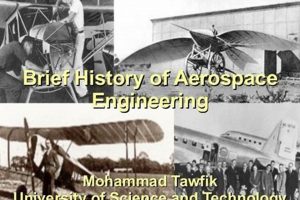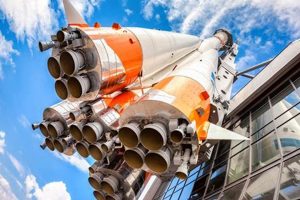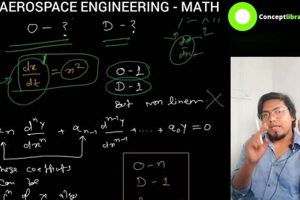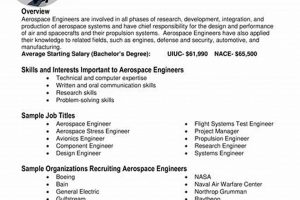Achieving a career as a specialist who supports the design, development, and testing of aircraft and spacecraft involves specific education, training, and skills acquisition. This path blends theoretical knowledge with practical application, focusing on the technical aspects of aerospace engineering projects.
This career offers the opportunity to contribute to advancements in aviation and space exploration. Individuals in this role are vital to ensuring the safety, efficiency, and innovation within the aerospace industry, building upon a legacy of technological progress.
The following sections detail the required educational background, necessary skills, certification opportunities, and typical career progression associated with this technically focused profession.
Essential Guidance for Aspiring Technicians
Pursuing a career in this specialized field requires a strategic approach to education, skill development, and professional networking. The following tips offer valuable insights for individuals seeking entry and advancement within this sector.
Tip 1: Obtain a Relevant Education: Completion of an associate’s degree in aerospace engineering technology, aviation maintenance, or a related field provides a fundamental understanding of engineering principles and technical skills. Coursework should include aerodynamics, materials science, and computer-aided design (CAD).
Tip 2: Acquire Hands-On Experience: Seek internships or entry-level positions at aerospace companies, research institutions, or government agencies. Practical experience working with aircraft components, testing equipment, and design software is invaluable.
Tip 3: Develop Strong Technical Skills: Proficiency in areas such as blueprint reading, mechanical systems, electrical wiring, and troubleshooting is crucial. Regularly update skills through workshops, online courses, and industry certifications.
Tip 4: Cultivate Problem-Solving Abilities: The ability to diagnose and resolve technical issues efficiently is essential. Develop analytical skills through practice and exposure to diverse engineering challenges.
Tip 5: Gain Industry Certifications: Obtaining certifications such as those offered by the FAA (Federal Aviation Administration) or professional organizations demonstrates competency and enhances career prospects. Research relevant certifications based on specific career interests.
Tip 6: Network with Professionals: Attend industry conferences, join professional societies, and connect with individuals working in aerospace engineering. Networking can provide valuable insights, mentorship opportunities, and potential job leads.
Tip 7: Stay Updated with Technological Advancements: The aerospace industry is constantly evolving. Remain informed about new technologies, materials, and manufacturing processes through industry publications, research journals, and continuing education.
Adhering to these guidelines can significantly enhance prospects in this competitive field, building a foundation for a successful and rewarding career.
The next section will delve into the potential career paths and earning potential associated with this profession.
1. Education and Training
Formal education and structured training form the bedrock upon which a successful career in aerospace engineering technology is built. The acquisition of knowledge and practical skills provides the necessary foundation for contributing to the design, development, and maintenance of aerospace systems.
- Associate’s Degree Programs
Completion of an associate’s degree in aerospace engineering technology, aviation maintenance, or a closely related field provides fundamental knowledge of engineering principles and technical practices. Curricula typically include coursework in aerodynamics, propulsion systems, materials science, and computer-aided design (CAD). For example, a graduate may possess the skills to interpret engineering drawings and perform basic structural repairs on aircraft.
- Technical School Certifications
Technical schools offer specialized certification programs that focus on specific aspects of aerospace technology, such as avionics, aircraft maintenance, or composite materials. These programs provide hands-on training and prepare individuals for entry-level positions in specialized areas. An example of a successful outcome is a technician certified in aircraft electronics, capable of troubleshooting and repairing complex electrical systems.
- On-the-Job Training
Many employers provide on-the-job training programs to supplement formal education. These programs offer practical experience under the supervision of experienced technicians and engineers, allowing individuals to apply their knowledge in a real-world setting. A typical training scenario involves assisting senior technicians with routine maintenance procedures, gradually progressing to more complex tasks.
- Continuing Education
The aerospace industry is characterized by rapid technological advancements. Continuing education is essential for technicians to stay abreast of new technologies, materials, and manufacturing processes. Workshops, online courses, and professional development programs provide opportunities to expand knowledge and skills. An example is a technician attending a workshop on additive manufacturing techniques for aerospace components.
These facets of education and training are interconnected and contribute to the development of a well-rounded and competent aerospace engineering technician. A solid educational foundation, coupled with practical experience and a commitment to continuous learning, is critical for success in this demanding and rewarding field.
2. Technical Skill Development
Proficiency in specific technical skills is paramount for individuals seeking entry into the aerospace engineering technician profession. Competence in these areas enables technicians to effectively contribute to the design, development, testing, and maintenance of aircraft and spacecraft systems.
- Blueprint Reading and Interpretation
The ability to accurately read and interpret engineering blueprints is fundamental. Technicians must understand technical drawings to fabricate components, assemble systems, and perform repairs according to design specifications. Incorrect interpretation can lead to critical errors in manufacturing or maintenance, compromising the safety and performance of aerospace vehicles. For example, a technician must be able to identify material specifications, tolerances, and critical dimensions from a blueprint to ensure proper part fabrication.
- Computer-Aided Design (CAD) and Manufacturing (CAM) Software
Proficiency in CAD and CAM software is increasingly essential. Technicians use these tools to create and modify designs, simulate performance, and generate instructions for automated manufacturing equipment. Mastery of CAD/CAM allows for efficient and precise production of aerospace components, reducing errors and streamlining the manufacturing process. As an illustration, a technician might use CAD software to design a prototype wing component and then use CAM software to generate the toolpaths for a CNC milling machine to manufacture the part.
- Materials Testing and Analysis
Knowledge of materials testing and analysis techniques is crucial for evaluating the properties and performance of aerospace materials. Technicians conduct tests to determine the strength, durability, and resistance to environmental factors of materials used in aircraft and spacecraft construction. Accurate material testing ensures that components meet stringent performance requirements and can withstand the harsh conditions of flight. For instance, a technician may perform tensile strength tests on a composite material to verify that it meets the required load-bearing capacity.
- Troubleshooting and Diagnostics
The ability to effectively troubleshoot and diagnose technical problems is critical for maintaining and repairing aerospace systems. Technicians must be able to identify the root cause of malfunctions, using diagnostic tools and systematic problem-solving techniques. Efficient troubleshooting minimizes downtime and ensures the continued safe operation of aircraft and spacecraft. As an example, a technician might use diagnostic software to identify a faulty sensor in an aircraft’s flight control system.
These technical skills, acquired through education, training, and practical experience, are indispensable for aspiring aerospace engineering technicians. Developing competence in these areas enhances career prospects and enables meaningful contributions to the aerospace industry, furthering the possibility to become an aerospace engineering technician.
3. Industry Certifications
Acquiring industry certifications is a strategic element for individuals pursuing a career as an aerospace engineering technician. These credentials validate competency and signal expertise, enhancing employment prospects and career advancement potential within the competitive aerospace sector.
- FAA Airframe and Powerplant (A&P) Certification
The Federal Aviation Administration (FAA) A&P certification is a widely recognized and respected credential for aircraft mechanics. Obtaining this certification demonstrates proficiency in maintaining and repairing aircraft airframes and engines. Technicians with A&P certification are qualified to perform maintenance on a wide range of aircraft, from small general aviation aircraft to large commercial airliners. For example, an A&P certified technician can inspect, repair, and overhaul aircraft engines, landing gear, and hydraulic systems, ensuring the airworthiness of the aircraft.
- National Institute for Metalworking Skills (NIMS) Certifications
NIMS certifications validate skills in metalworking and manufacturing processes, relevant to the fabrication and machining of aerospace components. These certifications demonstrate competency in areas such as CNC machining, milling, and turning. Aerospace technicians with NIMS certifications can contribute to the precision manufacturing of parts used in aircraft and spacecraft. As an illustration, a technician with a NIMS CNC milling certification can program and operate a CNC machine to produce complex aerospace components to tight tolerances.
- American Society for Nondestructive Testing (ASNT) Certifications
ASNT certifications demonstrate expertise in nondestructive testing (NDT) methods, which are used to inspect materials and components without causing damage. NDT techniques, such as ultrasonic testing, radiography, and eddy current testing, are essential for detecting defects and ensuring the structural integrity of aerospace components. Technicians with ASNT certifications play a critical role in ensuring the safety and reliability of aircraft and spacecraft. For instance, an ASNT certified technician might use ultrasonic testing to inspect aircraft wings for cracks or corrosion.
- Composite Material Certifications
With the increasing use of composite materials in aerospace applications, certifications in composite repair and manufacturing are becoming increasingly valuable. These certifications demonstrate competency in working with composite materials, including carbon fiber, fiberglass, and Kevlar. Technicians with composite certifications can repair damaged composite structures on aircraft and manufacture composite components for new aircraft designs. A practical application includes a technician repairing a damaged composite wing section on a commercial aircraft.
These certifications represent recognized standards of competence within the aerospace industry. Strategic acquisition of relevant industry certifications, aligned with career goals, can significantly enhance employment opportunities and advancement prospects for those seeking a career path as an aerospace engineering technician, solidifying their path on how to become an aerospace engineering technician.
4. Practical Experience
Gaining hands-on experience is an indispensable element in the path to becoming an aerospace engineering technician. It provides the opportunity to apply theoretical knowledge in real-world scenarios, develop essential skills, and build a professional network, solidifying one’s readiness for the profession.
- Internships and Co-op Programs
Participating in internships or cooperative education programs within aerospace companies, research institutions, or government agencies offers invaluable exposure to the industry. These programs provide opportunities to work alongside experienced professionals, contribute to ongoing projects, and gain practical skills in areas such as design, testing, and maintenance. For example, an intern might assist in the assembly of aircraft components, conduct performance tests on propulsion systems, or contribute to the design of new aerospace vehicles. These experiences significantly enhance career prospects by demonstrating practical competence and providing a competitive edge in the job market.
- Entry-Level Positions
Securing entry-level positions, such as technician’s assistant or junior technician, provides a foundation for career advancement. These roles offer opportunities to develop fundamental skills and gain familiarity with industry standards and practices. Entry-level technicians typically work under the supervision of experienced professionals, assisting with routine tasks and gradually progressing to more complex responsibilities. As an example, a junior technician might assist with aircraft maintenance procedures, troubleshoot electrical systems, or perform basic repairs on aerospace equipment. This early career experience is crucial for building a solid foundation of skills and knowledge, serving as a stepping stone to more advanced roles.
- Military Experience
Military service in roles related to aviation maintenance or aerospace technology can provide valuable practical experience and technical training. Military technicians often receive extensive training in aircraft maintenance, electronics, and other specialized areas. This experience can translate directly into civilian careers as aerospace engineering technicians, offering a pathway for veterans to transition into the industry. For instance, a veteran with experience maintaining military aircraft may possess the skills and knowledge required to work as an aircraft maintenance technician in the civilian sector.
- Personal Projects and Hobbies
Engaging in personal projects and hobbies related to aerospace technology can supplement formal education and provide opportunities to develop practical skills. Building model aircraft, participating in amateur rocketry, or experimenting with electronics can foster a deeper understanding of aerospace principles and enhance problem-solving abilities. These activities demonstrate a genuine interest in the field and can be valuable additions to a resume or portfolio. As an illustration, an individual who builds and flies model aircraft might develop a better understanding of aerodynamics and aircraft design principles, which can be beneficial in a future career as an aerospace engineering technician.
These avenues for gaining practical experience are instrumental in shaping a successful career trajectory. By actively pursuing these opportunities, aspiring aerospace engineering technicians can acquire the skills, knowledge, and professional network necessary to thrive in this dynamic and technically demanding field and, as such, is an essential piece of knowing how to become an aerospace engineering technician.
5. Continuous Learning
The aerospace industry is characterized by relentless technological advancement and evolving regulatory standards. Therefore, ongoing professional development is not merely advantageous but an essential component of a successful and sustained career as an aerospace engineering technician.
- Staying Abreast of Technological Advancements
The rapid pace of innovation in materials science, propulsion systems, avionics, and manufacturing processes requires constant learning. Technicians must actively seek out opportunities to expand their knowledge of new technologies to effectively contribute to projects and maintain their relevance in the field. For example, a technician might attend workshops or online courses to learn about composite materials repair techniques or the integration of artificial intelligence in aircraft systems. This ensures their ability to work on cutting-edge projects and maintain their value to employers.
- Maintaining Regulatory Compliance
The aerospace industry is heavily regulated to ensure safety and airworthiness. Regulations and standards are regularly updated, and technicians must stay informed to comply with these changes. Failure to adhere to regulations can have severe consequences, including fines, loss of certifications, and potential safety hazards. For instance, technicians need to remain current on FAA airworthiness directives and maintenance procedures to ensure compliance during aircraft inspections and repairs.
- Expanding Skill Sets
Continuous learning allows technicians to broaden their skill sets and become more versatile. Acquiring expertise in multiple areas, such as electronics, hydraulics, and composite materials, increases their value to employers and opens up opportunities for career advancement. For example, a technician who initially specializes in avionics might pursue additional training in aircraft structural repair, making them a more well-rounded and valuable asset to their team.
- Pursuing Advanced Certifications and Training
Obtaining advanced certifications and participating in specialized training programs demonstrates a commitment to professional development and expertise in specific areas. These credentials can enhance career prospects and lead to higher-paying positions. For example, a technician might pursue advanced certifications in nondestructive testing or aircraft engine overhaul to demonstrate specialized skills and knowledge.
In conclusion, commitment to continuous learning is vital for aerospace engineering technicians aiming to maintain professional relevance, uphold safety standards, and advance their careers. Actively engaging in ongoing education, training, and skill development directly contributes to a successful and rewarding career trajectory in this dynamic and highly technical field, reinforcing the path and understanding of how to become an aerospace engineering technician.
Frequently Asked Questions
The following section addresses common inquiries regarding entry into the aerospace engineering technician profession, providing clarity on educational requirements, skill development, and career prospects.
Question 1: What level of education is generally required?
A minimum of an associate’s degree in aerospace engineering technology, aviation maintenance, or a related field is typically required. Some employers may prefer candidates with a bachelor’s degree. The educational background provides the necessary foundation in engineering principles, materials science, and other relevant technical subjects.
Question 2: Are industry certifications necessary?
While not always mandatory, industry certifications such as FAA Airframe and Powerplant (A&P) licenses or certifications in nondestructive testing (NDT) significantly enhance employment opportunities and demonstrate competence to potential employers. These certifications validate specific skills and knowledge relevant to the industry.
Question 3: How important is practical experience?
Practical experience is highly valued. Internships, co-op programs, and entry-level positions provide opportunities to apply theoretical knowledge in real-world scenarios. Hands-on experience with aircraft components, testing equipment, and design software is crucial for developing the necessary skills and building a successful career.
Question 4: What are the key technical skills required?
Essential technical skills include blueprint reading and interpretation, proficiency in CAD/CAM software, materials testing and analysis, and troubleshooting and diagnostics. These skills enable technicians to effectively contribute to the design, development, testing, and maintenance of aerospace systems.
Question 5: How crucial is continuous learning in this field?
Given the rapid pace of technological advancements in the aerospace industry, continuous learning is essential. Technicians must stay updated with new technologies, materials, and manufacturing processes through workshops, online courses, and professional development programs.
Question 6: What are the potential career paths and advancement opportunities?
Career paths can include specialization in areas such as avionics, propulsion systems, or composite materials. Advancement opportunities may involve moving into supervisory roles, project management, or engineering support positions, dependent on experience, performance, and additional education.
These points highlight the key aspects of pursuing a career in this technical field. Success hinges on a combination of formal education, practical experience, and a commitment to continuous professional development.
The subsequent section explores the potential earnings and long-term career outlook for aerospace engineering technicians.
Concluding Remarks
This article has explored the multifaceted process concerning “how to become an aerospace engineering technician.” It has detailed the critical role of education, the acquisition of essential technical skills, the value of industry certifications, the importance of practical experience, and the necessity of continuous learning. These elements, when strategically addressed, contribute to a solid foundation for a successful career in this technically demanding field.
Prospective technicians are encouraged to meticulously plan their education and training, actively seek opportunities for practical application of their skills, and remain committed to lifelong learning. The aerospace industry demands competence, precision, and adaptability, and a dedicated approach to professional development will ultimately determine long-term success and contribution to this vital sector.







